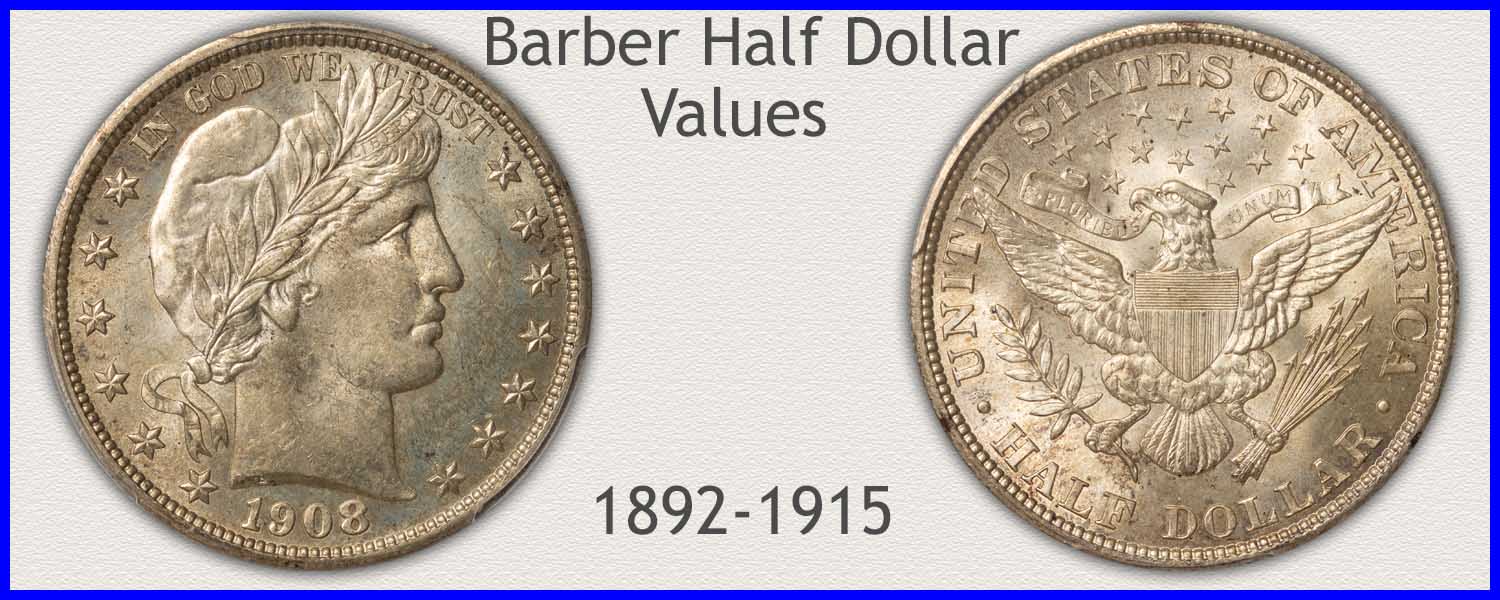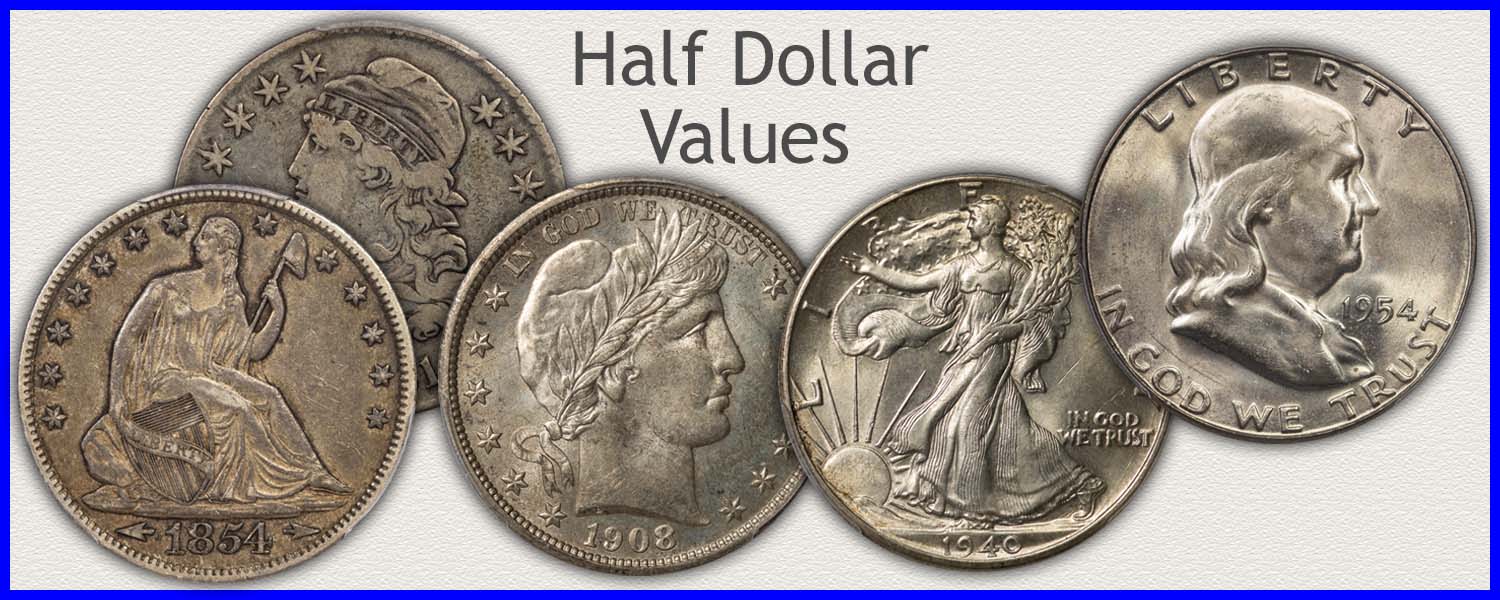Coin Values Moving with Precious Metals: Up-Dated 12/29/2025: Gold $4449 | Silver $75.46
1892 Half Dollar Value
Because of their status, first of series halves are forever an important year in Barber coinage.
Images are used to identify mintmarks from the various mints to narrow 1892 half dollar value. Collecting Barber halves and forming complete sets involves determining the exact date and mint variety. Because of interest from collectors, there are now higher premiums for the scarce mint varieties.
In addition, following a defined method, the chart indicates that better-preserved coins are also scarce and in high demand. After identification of mintmarks, a set of grading photographs is used to establish condition.
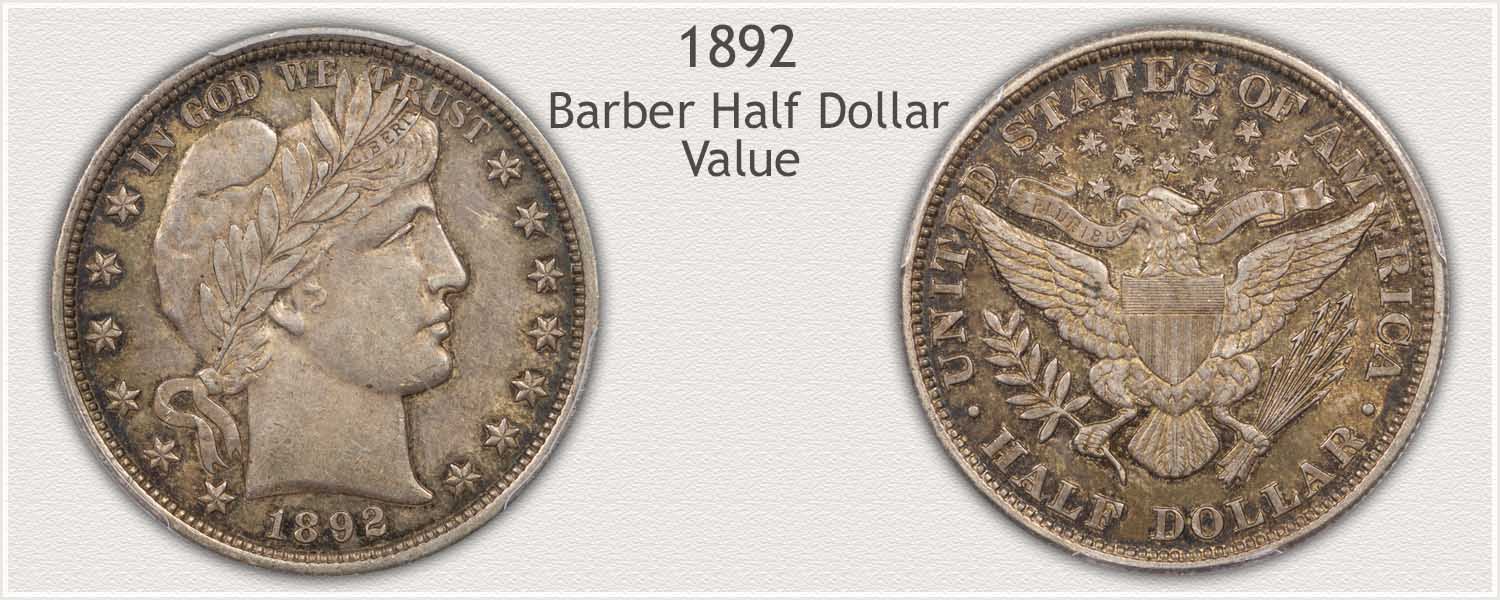
Steps Leading to Value:
- Step 1: Date and Mintmark Variety - Confirming the mintmark and Mint of issue is the essential first feature to record.
- Step 2: Grading Condition - A range of values depending on condition of the coin is narrowed by determining its state of preservation.
- Step 3: Special Qualities - Collectors support the value to old coins. A historical perspective of these first year coins further supports a continued interest.
| 1892 Half Dollar Value | ||||
|---|---|---|---|---|
| Condition of Coin | ||||
| Date | Good | Fine | Extremely Fine | Mint State |
| Barber Half Dollar Values Updated | 12/29/2025 | |||
| 1892 | $60.36 | $81 | $181 | $515 |
| 1892 O | $205 | $531 | $625 | $970 |
| 1892 S | $200 | $393 | $546 | $1,188 |
Listed on the chart is a range of Wholesale values of Barber half dollars. Identifying mintmarks is an important factor to confirm. See Step 1: just below.
Step 1: | Importance of Date and Mintmark to 1892 Half Dollar Value
Date and Mint Combinations to Identify
Beginning a new series of half dollars, the Barber design began in 1892. Three mints across the country struck the new coins, each in different quantities. Availability of these different issues today shows as a scarcity of halves minted by the branch mints.
Popularity of the first coin in a design series captures the attention of collectors. They strive to obtain an example from each mint variety of the year. Carefully inspect for mintmarks to assure an accurate reading of the value chart.
1892-S Barber Half Dollar
"S" Mintmark on Reverse: San Francisco Mint Struck the Coin
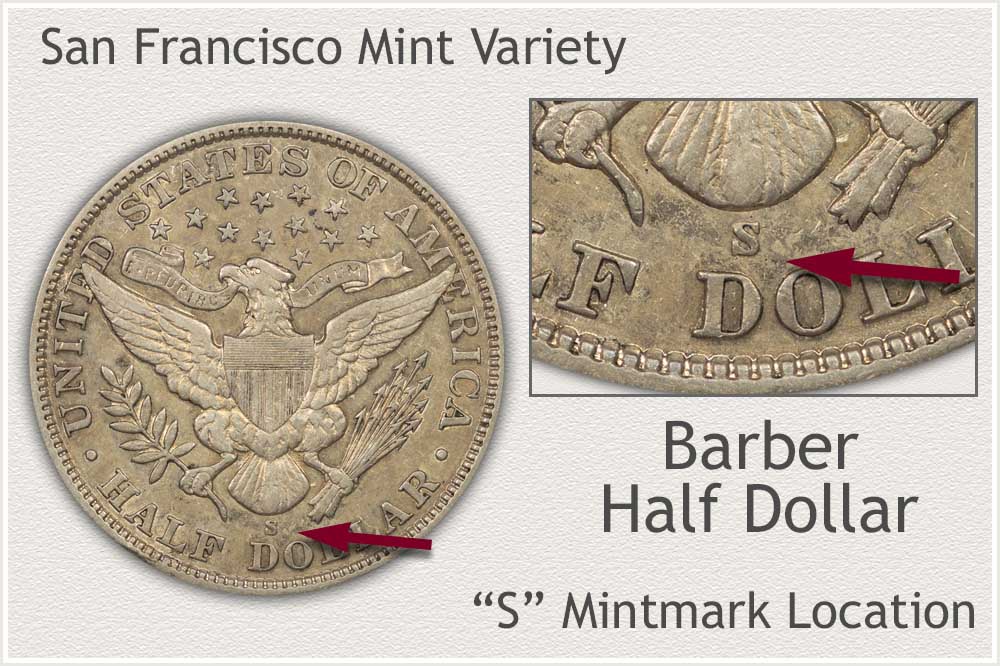
An accurate description of a coin includes the date and mint variety. 1892 half dollars are significant as the first year of the series, and the western mint in San Francisco issued just over one million into circulation. Because of its low numbers produced, these are a highly valued coin. Few were saved from circulation, as seen by the premiums on the chart. Virtually all are considered collectible in any grade, an important coin to find.
Confirm the San Francisco issue by the "S" mintmark on the reverse. Below the eagle the "S" mintmark is clearly visible. An in-demand collectible.
1892-O Barber Half Dollar
"O" Mintmark on Reverse: New Orleans Mint Struck the Coin
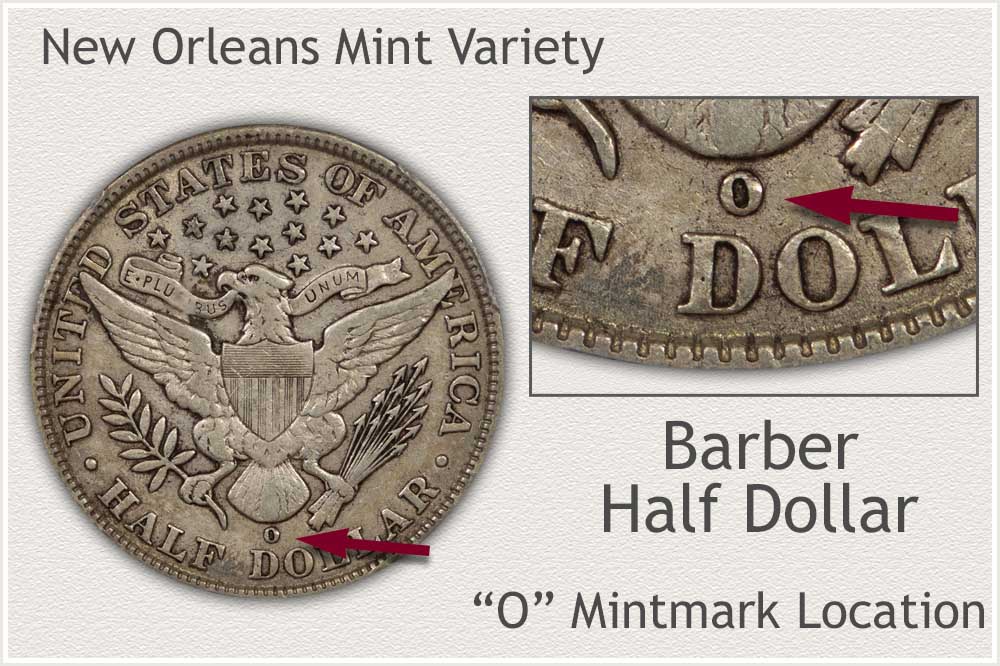
The New Orleans mint was one of three mints contributing to the initial release of the new 1892 Barber half dollar series. Striking what became the lowest number of halves for a yearly total, only 390,000 were produced. These are now recognized as a scarce issue. Additionally, with the status of "first year of series" and the special interest of collectors with the New Orleans mint, all show a high premium on the value chart.
New Orleans was a branch mint serving the South, and all its coinage features an "O" mintmark. Identify the mint by finding the large "O" mark on the reverse in the lower area of the coin, above the "D" of DOLLAR.
1892 Barber Half Dollar
No Mintmark on Reverse: Philadelphia Mint Struck the Coin
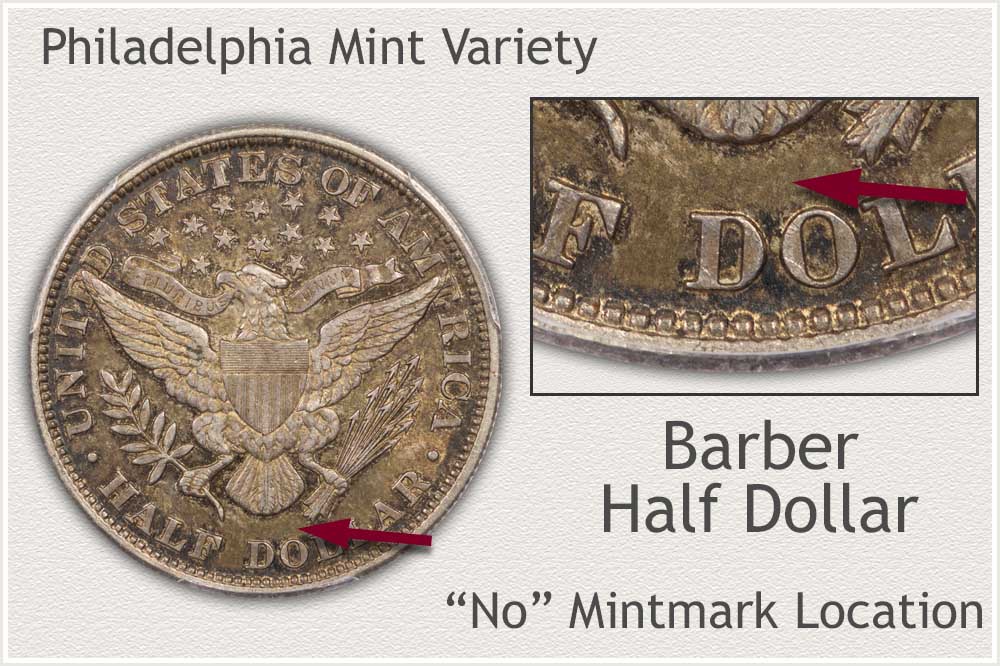
The beginning of the series saw Philadelphia strike a moderate amount of 1892 half dollars. Interestingly, total mintage was just over 935,000 pieces, an under one million amount. In most cases, less than a million struck indicates a scarce coin, especially from the Barber series. However, saving these at the time as keepsakes now provides for today's collector.
Listed on the chart, values in heavily worn condition are closely tied to silver content. These are a popular issue with collectors because of affordability and "first year" of issue. Placing an accurate value requires correct identification.
Confirming the Philadelphia variety is the absence of a mintmark on the reverse. Philadelphia is the main U.S. mint, and at the time, did not use mintmarks to identify its coinage. Inspecting the reverse, look just below the eagle. If the space is empty, Philadelphia struck the coin.
Step 2: | Wear is Judged and Grade Determined
Grading Defines Condition of 1892 Halves
By judging the amount of wear present on a Barber half dollar, collectors begin to establish a grade of its condition. Standards for these wear levels are compared to define a narrow grade range.
As metal is removed from old coins, recognizable patterns develop on certain design features. Below are images of grades, and specific areas to examine and judge amount of wear.
Mint State Grade
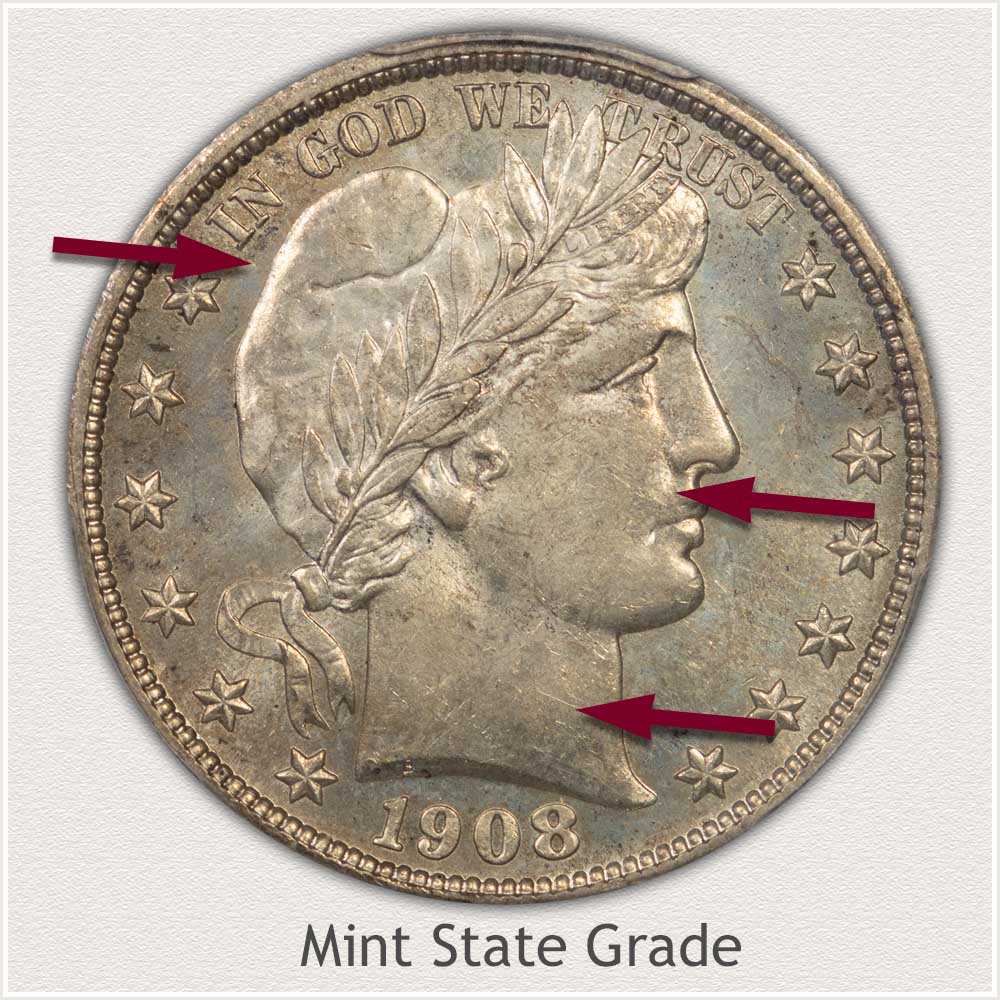
Mint State: High condition coins require careful handling. Hold all coins by the edges to ensure not touching the surface. A Mint State coin is defined as - no wear - to the surface; gentle handling maintains the state of preservation. Inspecting the surface closely and identifying the likely areas to receive any wear confirms the grade.
Liberty's portrait features open areas, her cheek, neck, and cap, and is also composed of fine details, hair, leaves, and her headband. Inspecting the open areas, her cheek and neck remain covered with luster, a fine grain texture. Any wear to these areas dulls and smooths the surface, a distinct difference when compared to lower relief areas.
Mint state condition is confirmed by inspecting the cap at the top of Liberty's head. This high area also remains covered in luster and shows no smoothness or dulling of the metal.
Helping judge the mint state grade are the smaller, finer details of the leaves, which are all without any loss of detail. Edges of the leaves are well defined, with no flat areas, and inner raised contours show no signs of smoothing.
Extremely Fine Grade
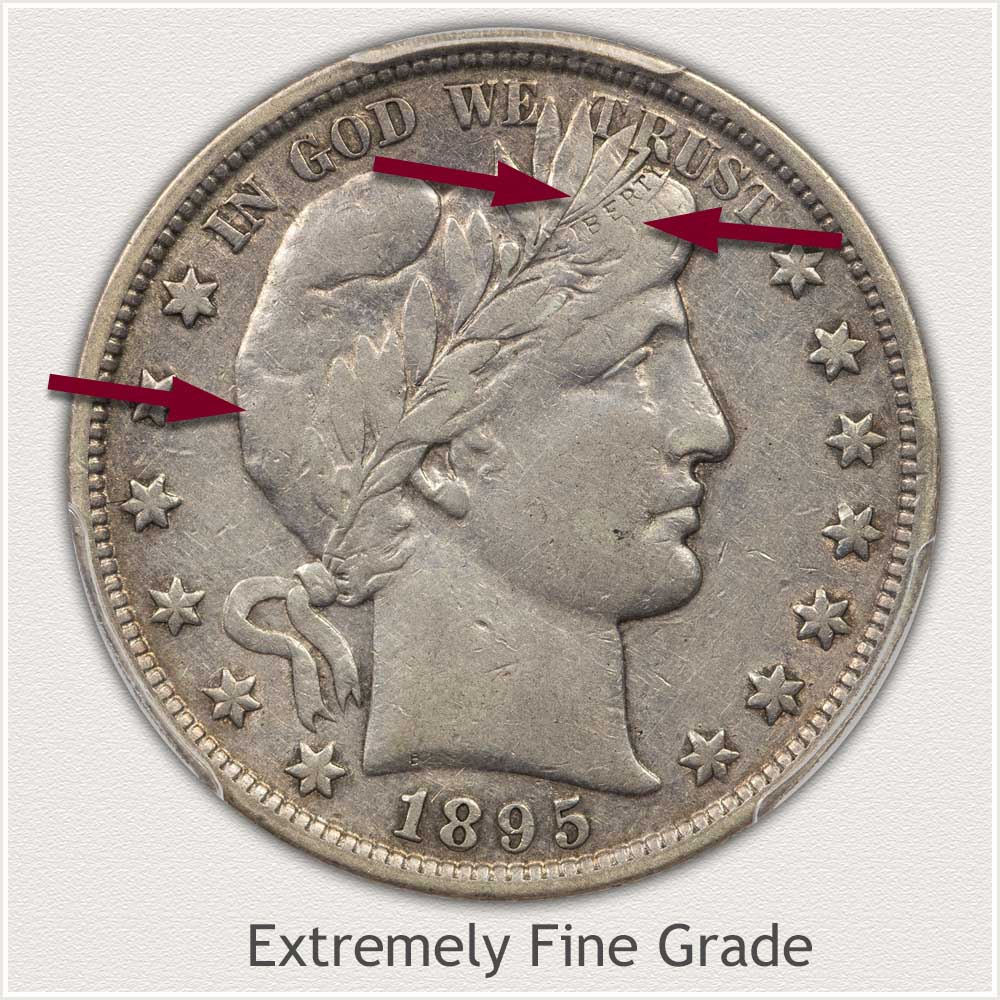
Extremely Fine: As a result of light wear visible only on the highest relief points of the design, a half dollar is considered Extremely Fine condition. Overall, there is minimal metal loss, and the condition of the coin displays a high level of detail.
Several key areas are examined and judged in order to confirm the light wear standard. Of interest includes the letters "LIBERTY" on her headband, the headband itself, and the amount of wear on Liberty's cap.
For a coin to qualify for the grade, the lettering of LIBERTY as part of the headband, must show full, clear, and easily readable. Each letter remains deeply impressed; often, a close look is required to judge whether the ending "Y" is complete. Next, viewing the headband, there is only a small amount of softness on the bottom edge of the ribbon. The top edge, however, is strong and complete.
In addition, Liberty's cap still retains visible folds and contours. The contours are minimally flattened, and there are only a few areas of smoothness. This half dollar is in high condition and is characterized by crisp details.
Fine Grade
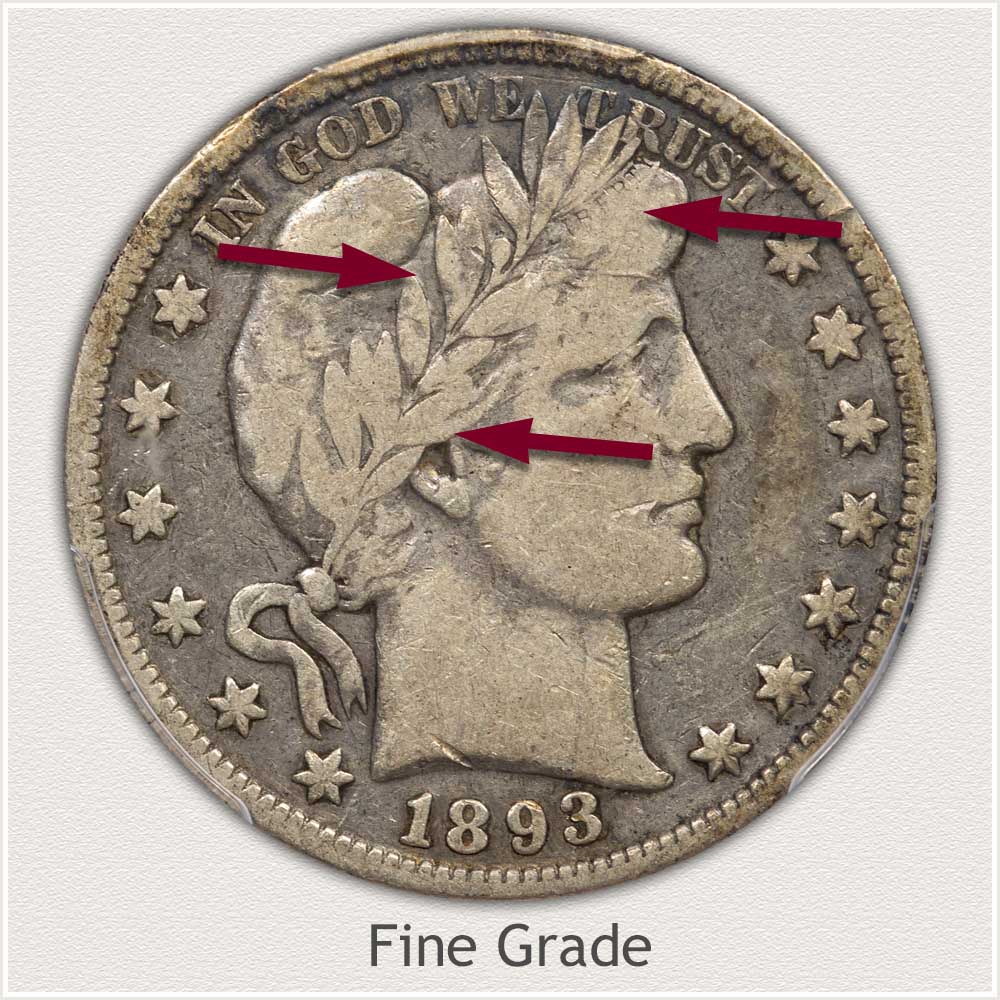
Fine Grade: Defining a Barber half dollar in Fine condition requires visible small details, a slight merging of design, and a remaining sharpness to the overall appearance.
There is a balance between missing detail and remaining detail on these collectible quality coins. As an example, all letters of "LIBERTY" are visible above the forehead. However, visible wear is also very apparent. A few letters are weak, and the ribbon containing the lettering is well worn, notability along the lower edge blending with her forehead.
An important qualifier to the Fine grade is ample detail of the laurel wreath. Within Liberty's hair, a well-detailed upper row of leaves is crisply outlined. However, the lower row is missing full definitions along the leaf edges. This combination of visible and missing leaf design places its condition within the Fine grade category.
A quality look to the coin is apparent, along with a distinctly worn appearance. A soft gray color of silver with deeper tones along the rim highlights remaining design and provides a pleasing appearance.
Good Grade
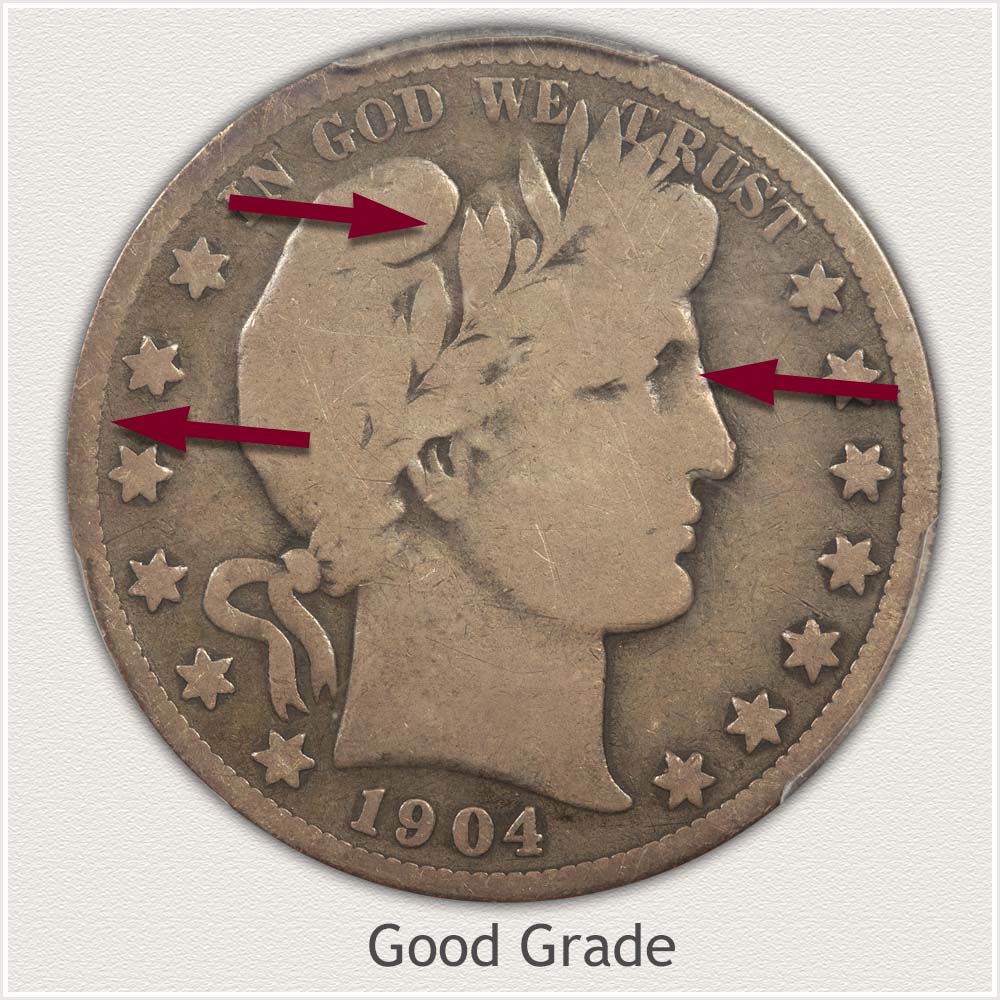
Good Grade: In the central area of a Good grade Barber half dollar, there is just a small amount of detail visible. These coins are described as highly worn, with significant details lost. This is defining the Good grade.
Liberty's eye area is detailed, and also a complete outline of the portrait is visible. Even though Liberty is worn quite smooth, a few central devices are often visible. One crucial element to examine to confirm the good grade is the entire portrait remains bold abve the coin's field. Notable are the outlines of the very top leaves in the wreath are complete.
A full and broad rim with a clear separation from the stars gives the condition a special crispness. In addition, the entire lettering of the motto is fully readable. Matching your coin to the half dollar imaged and showing a bold date remaining is an attractive quality "Good Grade" collectible.
How to Video: Grading Barber Half Dollars
Grading is expanded in greater detail, covering the subtle points of different conditions. Images highlight design details needed to determine a narrow grade range.
Video, Images and Descriptions | Grading Barber Half Dollars
Step 3: | Special Qualities and Collector Interest Value
First of Design Series and Historical 1892 Half Dollars
A new collectible series of half dollars was begun in 1892. At the time is was named by the mint as Liberty halves, today this vintage series is referred to as Barber coinage. Charles E. Barber, with a persistent effort, was instrumental in designing and seeing it move into production. Collectors today are comfortable with the name, distinguishing it from the former series of Seated Liberty coinage.
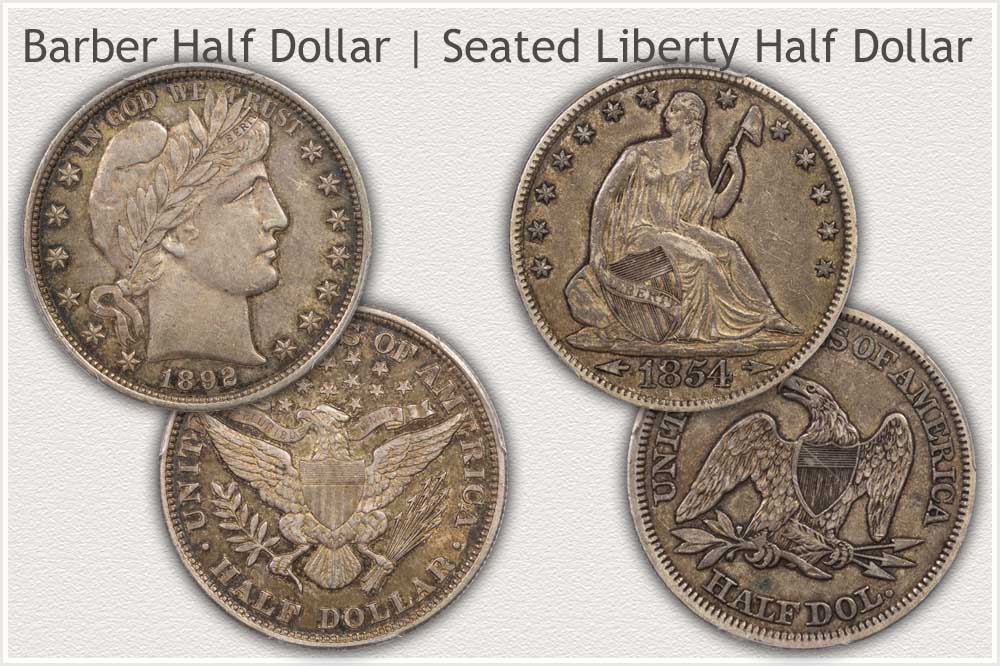 A New Barber Half Dollar Replacing the Seated Liberty Half Dollar Series
A New Barber Half Dollar Replacing the Seated Liberty Half Dollar Series
Each major change in design is historical to U.S. coinage. The new half dollar features a portrait of Liberty on the obverse. With a reverse design similar to the earlier eagle and shield representations. Large both in size and value, they supplied needed coins to commerce.
Three mints operated at the time; all struck 1892 halves. Branch mints, New Orleans and San Francisco, along with the main mint in Philadelphia. All produced low numbers of these halves in comparison to later years, with New Orleans a record low of just 390,000 pieces.
Values of branch mint "first of series" half dollars show a large collectible premium in all states of preservation, including heavily worn examples. Interest and demand for a first-year coin is found among new to advanced collectors and collections. 1892 half dollars are important to a date and mint collection and also fits nicely in a theme type set of different half dollar design series.
1892 Barber half dollars have a strong initial base in their large silver content. Added is historical significance of a new design, plus "first of series" status. Finding one in nice, well detailed condition is a coin with many special qualities.
References
U.S. Mint. 1891 U.S. Mint Annual Report
https://nnp.wustl.edu/library/book/512060
U.S. Mint. 1893 U.S. Mint Annual Report
https://nnp.wustl.edu/library/book/317
Coin Values | CoinStudy Articles
Date by Date
In Depth Barber Half Dollar Values
1892 to 1915
Barber Half Dollar Value | Scarce Date and Mint Varieties
1892 Barber half dollar is part of a long running design series. The many date and mint varieties are covered in detail and listed on the value chart. Confirm date and mint combination, judge condition to narrow how much these old half dollars are worth.
Half Dollar Value | Identify the Different Series
Barber half dollars are part of the long running 50 cent denomination. Half dollars, first minted in 1794, cover many designs, scarce to rare dates, and valuable mint varieties. Images of the designs help recognize the different series with links to value charts and the steps needed to accurately judge the coin.
Old Coin Values | Recognize Key Steps
Introduced in detail is a method following key steps to fully determine a value of old coins. The coinage of the U.S. began in 1793 and continues with many different design series and denominations. Using the same process as collectors, determine an accurate identity and description of both Barber half dollars and any series of coins from cents to U.S. gold coinage.
Safe Coin Storage | Half Dollar Recommendations
Barber half dollars need safe storage to protect their value. Large coins when kept together tend to nick, abrade, and continue to lower condition of both themselves and other coins. Review the holders and storage products available to the coin collecting hobby specific to safely housing these old coins.
Popular Coin Series | Barber Half Dollars
Demand by collectors is the base to collectible value of Barber half dollars. Silver value is quickly surpassed when the supply of coins is scarce. Popularity of the many U.S. coin series is charted, showing the strength of each.
Coin Grading Services | Authenticate and Grade of Coins
Professional grading services are routinely used by collectors to authenticate and grade the condition of higher valued, premium collectible coins. The top two in the coin community - NGC and PCGS grade and encapsulate coins with market accepted grading judgements. Review their services. Many Barber halves are in the premium value range, and accurate grading is key to accurate value.
★Coin Values Discovery finds 1892 Barber Half Dollar Value and...
Coin values index. Dates, mints, and condition are covered by following images to the different series, all valued individually. Follow the step-by-step method, comparing your coin to descriptions and images helping identify the important qualities to a narrow value range.
